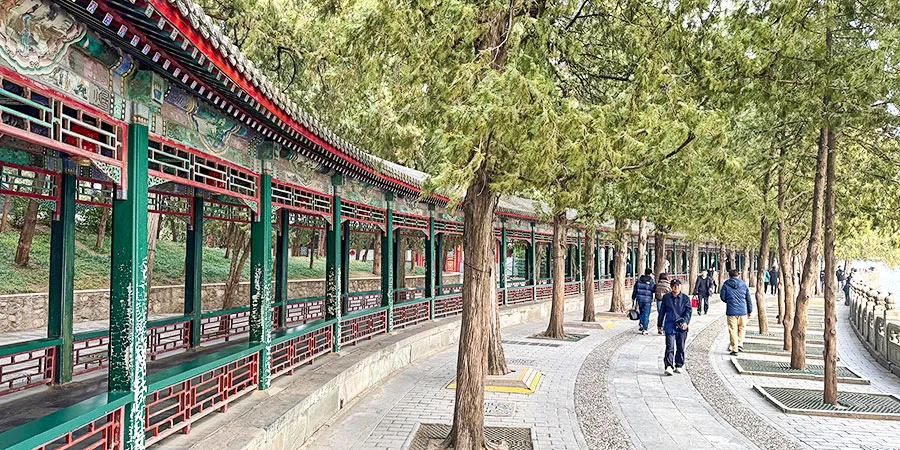Long Gallery (Changlang)
The Long Gallery was first built in the fifth year of the reign of Emperor Qianlong (1750; some say 1749). A memorial indicates that it had been almost completed four years later. The emperor built the gallery for his mother to so she could walk out doors regardless of the weather so she might view the garden in rain or snow. It was destroyed in 1860 and rebuilt in 1886. The Empress Dowager Cixi would like to walk here after breakfast every day. Long Gallery was constructed along the natural terrain of Longevity Hill and the turns of Kunming Lake, offering a picturesque view with each step.
 |
| The Long Gallery |
Starting from the Yaoyue (Inviting-Moon) Gate in the east and ending with Shizhang Pavilion in the west, the Long Gallery has 273 ‘rooms’, each room being the space between two pairs of columns that support the roof. In the center is the Gate of Dispelling Clouds. There are two octagonal pavilions at the eastern and western ends of the Long Gallery. The four octagonal pavilions each symbolize a season. They are exquisitely named Liujia (Retaining the Goodness) Pavilion, Jilan (Reposing Ripple) Pavilion, Qiushui (Autumn Water) Pavilion and Qingyao (Clear and Carefree) Pavilion, from east to west. Apart from two waterside pavilions near to the west and east ends of the corridor, there is a three-storey building on the northwest connected to the Long Gallery by a short corridor. The sloping gallery west of the building leads to the Hall of Listening to Orioles.
Galleries or corridors have long been a part of ancient Chinese architecture. There are different types, such as the two-storied gallery, slopping gallery, a zigzag veranda, a corridor over water and a cloister. Buildings of the Tang Dynasty were usually surrounded by galleries that connected individual houses together. Covered corridors were usual features in big courtyard dwellings and gardens. The construction of the galleries is simple but they play important role as a shelter to keep out rain and snow and as a point in garden to connect attractions and also as a guidance to lead the way.
Another highlight of the Long Gallery worthy of careful attention is the 14,000 Su style colored paintings every beam and cross-member. It enjoys the title of ‘the colored paintings museum’. Paint can protect wood structures from depredation by insects, rain, wind and sunlight. So they could endure for a long time, the paints were made from the raw colors of minerals. Because of its length and abundance of colored paintings, the Long Gallery was included in the Guinness Book of Records in the early 1900s.
|
|
There are hundreds of painted stories inside the Long Gallery, and the themes taken from historical figures, landscapes, flowers and birds can be seen as a miniature representation of the breadth of Chinese art. Appreciating the intricate paintings while listening to the profound stories, myths and legends, for example, Pilgrimage to the West, visitors can learn a lot about the five-thousand-year-old Chinese culture. There are no written descriptions on the actual paintings. Visitors can guess a story from the settings, clothes and movements. In addition, the various birds and flowers that are depicted have different allegoric meaning.
 |
Worthy of mention is the fact that the main part of each picture followed the semicircular line of a girder; there was no set framework for the painting; images were created from artists' inspirations. Most of the paintings are typical ‘Su-style Colored Paintings’ (a kind of Chinese classical painted decorative art on wooden buildings). It was so named because of the style was initiated in the Suzhou, Hangzhou area. This kind of painting in Chinese architecture was favored and used in the imperial gardens because they can vividly express rich amount of contents, compared with other types of paintings in the imperial palace to represent dignity and solemnness. Those painting in thick and heavy colors in the Long Gallery are really striking decorations, revealing the grandeur of the largest imperial garden, the Summer Palace.
![]() Next: Hall of Dispelling Clouds
Next: Hall of Dispelling Clouds
![]() Related Link: Summer Palace Travel Tips
Related Link: Summer Palace Travel Tips

